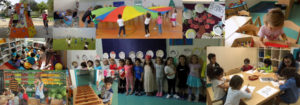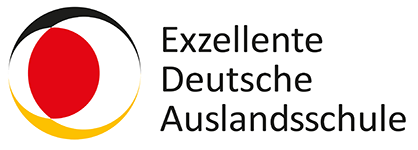
The pedagogical work of the kindergarten is based on the Thuringian education plan and its seven educational areas.
These areas of education do not represent subjects in the academic sense and cannot be distinguished from one another in everyday pedagogy. The individual areas of education overlap resulting in a holistic and interconnected education work.
In addition to these educational areas, learning fields unfold spontaneously and situationally. Stimulus for such further learning fields can, for example, be driven by the children’s interests, current events in the environment or in the kindergarten, and new educational material.
Emotional competence and social relations
Emotional competence and social relationships are fundamental prerequisites for coping with life. Stable and secure relationships provide children with a sense of security and contribute to the child’s well-being. They promote the children’s confidence in themselves and in the environment. In kindergarten, children get the opportunity to develop diverse relationships with other children and adults and learn to treat each other respectfully. We enable the children to experience a sense of community, to shape social cohesion and to assume responsibility. The children develop interest in others, make friends and cultivate friendships and contribute to group decisions. They develop social skills such as the willingness to help, empathy, the ability to manage conflict, motivation, assertiveness, speaking up for oneself and others, and tolerance. In gaining a positive self-awareness, children learn to understand and respect the thinking, feelings and actions of others.
An important task in the development of children is learning to deal with one’s own feelings and that of others.
Ethics and society
Ethics is a matter of a human being’s value and dignity and deals with just and unjust actions.
Charlotte Bühler, 2009
Individual differences with respect to social origin, skin colour, religion, cultures, and mental and physical abilities can be used as a basis for a respectful coexistence. The diversity of our world has to be conveyed to children in a positive manner and openness and tolerance have to be exemplified.
Achieving a child’s acceptance of above mentioned goals implies that the child:
- can develop self-confidence
- is not left alone in conflict situations
- s empowered to take up responsibility
- develops tolerance and respect for others
- can assess and accept his/her own strengths and weaknesses
We also want to introduce the children to customs and culture. Values and norms of our society, such as making polite requests, expressing gratitude and greeting each other, are very important to us.
Language and communication
Early knowledge of foreign languages promotes intellectual development. Children generally gain a greater awareness of languages and linguistic contexts. They are more creative when it comes to finding solutions to specific problems. They learn to think flexibly and seek alternative solutions. They try to express themselves well and empathize more with others who do not understand as well as they do.
The basic building blocks of any social relationship are verbal and non-verbal communication. From the moment of birth, communication is one of the basic human needs. Children communicate their desires, concerns and feelings by means of language. Children actively interact with other people, create relationships, and learn to master conflicts and tasks. Language conveys values and norms and is key to a successful educational biography.
In a variety of everyday situations, we support children in learning and differentiating linguistic competencies in their first and second language. Language acquisition is supported by linguistic exchange processes and linguistic stimuli in a familiar environment.
Initially, language comprehension is more extensive in language acquisition than language production. Body language, pictograms and symbols clarify and support language comprehension.
We attach great importance to the language spoken within the families because language and identity are closely related. It is important to develop the first language continuously in order to build up second language acquisition successfully.
It is our aim that the children of DIS Doha acquire a comprehensible colloquial language, have a good command of active and passive vocabulary, and can express themselves in a largely grammatically correct manner. We aim at initiating and preserving a joyful and motivational approach to language learning.
Contemporary elementary education comprises the promotion of media literacy. Media are embedded in educational programs that allow children to participate in actively. Media pedagogy includes traditional and new, digital, media. Picture books and radio plays are the first media children use. Children in our kindergarten get the opportunity to become acquainted with different media and to use them of their own accord. We encourage children to bring their own books and CDs from home to share their individual preferences with their friends at kindergarten.
Mathematical education in kindergarten
Children experience mathematics in interesting and significant contexts. They develop their own ways of researching their environment with regard to mathematical facts and problem solving by means of joint research, discovery and experimentation. Starting from concrete experiences and practical activities they arrive at the abstract, develop a mathematical basic understanding and deal with basic mathematical concepts. They learn that their own ideas and solutions are valuable and recognised. They also learn that errors and mistakes can be used constructively on the way to becoming a problem solver. Mathematical learning is closely linked to other areas such as music, sports, natural sciences and technology. Language is of particular importance because it provides the basis for mathematical thinking. Exchanging ideas develops and refines the basic mathematical understanding.
At the kindergarten of the DIS in Doha, we provide children with the opportunity:
- to discover, describe, continue or make simple patterns (ornaments, floor tiles, laid tile series, etc.)
- to learn about different classification systems (calendar, clock, etc.) and to discover structures therein
- to develop an understanding of numbers
- to perform size comparisons through activities such as measuring, weighing and comparing, and to sort objects according to various features
- to experience and describe spatial relationships and, in doing so, to use terms such as above, below, right and left
- to distinguish basic geometric shapes and their properties and to recognize them in the environment.
- For this purpose, we provide children with a wide variety of materials: beads, blocks, natural materials in various colours, shapes, sizes and weights
- take up the concept of quantity in everyday life (How many children are sitting in the morning circle today? How many children are absent today?)
- Scale, measuring cup, folding rule, clock, ruler
- Dice games
- stories with numbers, number rhymes , e.g. “Five little monkeys”
- recognizing structures of cycles (day and night, day’s schedule in kindergarten, year running, birthdays)
- experience with money (shopping, spending money, money)
- perceive distances and speeds (How many steps are there to the cafeteria?)
Movement and health
Every human form of expression is characterized by movement.
Movement and play are the appropriate ways that children deal with and influence the human and material environment, comprehend the world and construct a new one for themselves. Through movement, children conquer their environment and gain cognitive, affective and social competence.
Due to weather-related constraints and changes in childhood, movement is of great importance in our kindergarten. We integrate it daily into our kindergarten day. We attach great importance to offering both guided and free movement times. We teach the children to play games, play using rhythmic elements and provide relaxation exercises. In addition to the guided movement times, children have sufficient free movement times to act out their situational movement needs and spontaneous ideas.
In addition to physical health, psychosocial health is another necessity for education and the development of well-being. Therefore, we offer children the opportunity to learn about preventative measures for healthy living. Physical activities serve to maintain psycho-hygiene and a conscious handling of nutrition serves vitality. Conscious physical awareness enables children to recognize, regulate and articulate their own needs.
Aesthetics and design
I hear and I forget. I see and I remember. I do and I understand.
Confucius
The aesthetic education as a part of elementary education assumes that thinking in images is the basis for processes of designing and shaping. In the field of aesthetics, creativity manifests itself in various forms of artistic expression, such as graphic and sculptural design, play, dance, media design, and the examination of music and language.
From the moment they are born, children explore their environment with all their senses and gain their first aesthetic experiences. In early childhood, the foundation of education is learning through the five senses (sight, hearing, smell, taste, touch). In art, children can express their imagination, and also deal with their emotional moods. Children learn to use their senses for the perception of aesthetics, art and culture.
We as educators give children the opportunity to:
- creatively try out different materials and tools
- understand art as a way of access to other cultures (e.g., St. Martin, Eid Mubarak, etc.)
- develop joy in role-play games
- experience appreciation, recognition, fun, joy and pleasure in designing as a prerequisite for creative and imaginative playing, working and learning
- develop acceptance and tolerance, i.e., that the term “beauty” can mean something different for everyone
Music
Music is in all of us
Music has a positive effect on the development of children (intelligence, raising the awareness of senses and feelings, language development, etc.). Music fosters creativity, imagination, attention and perception. When singing, the child becomes aware of his or her voice and learns how to use it. While dancing, the child discovers how to convey expression with arms and legs, hands and feet. The use of instruments requires concentration and endurance and trains accurate listening. Since music transmits emotions, children can express themselves in a creative way by means of music.
Music is a constant companion that is embedded in the daily routine. It touches and supports our actions during morning circle, while tidying up, at birthday parties, in the rest period and during our concluding circle. The temporal, spatial and social structure of the kindergarten offers numerous opportunities to encourage and promote musical behaviour.
Nature and Technology
Basic scientific and technical knowledge are an integral part of the most important skills and abilities for lifelong learning. From the moment they are born, children experience numerous scientific, mathematical and technical phenomena in their environment. They are highly motivated to investigate and find out about the cause and effects. (Charlotte Bühler Institute, 2009)
We at the GIS Doha want to encourage children to relate their experience and skills to these new impressions – for example, by helping them with recognizing organizational structures and principles in the environment and by giving them the opportunity to test and try out different problem-solving strategies. Thus children can expand their knowledge and apply it to new situations.
Overview Kindergarten concept:
> Our Mission Statement
> Educational Orientation
> Daily Routine
> ”Open Work“
> Facilities
> Younger and older children under one roof
> Room and time to rest
> Areas of Education
> Learning experiences in the game
> Children in the last year in kindergarten
> Public relations
> Observation and Documentation
> Quality Assurance
This post is also available in: German




